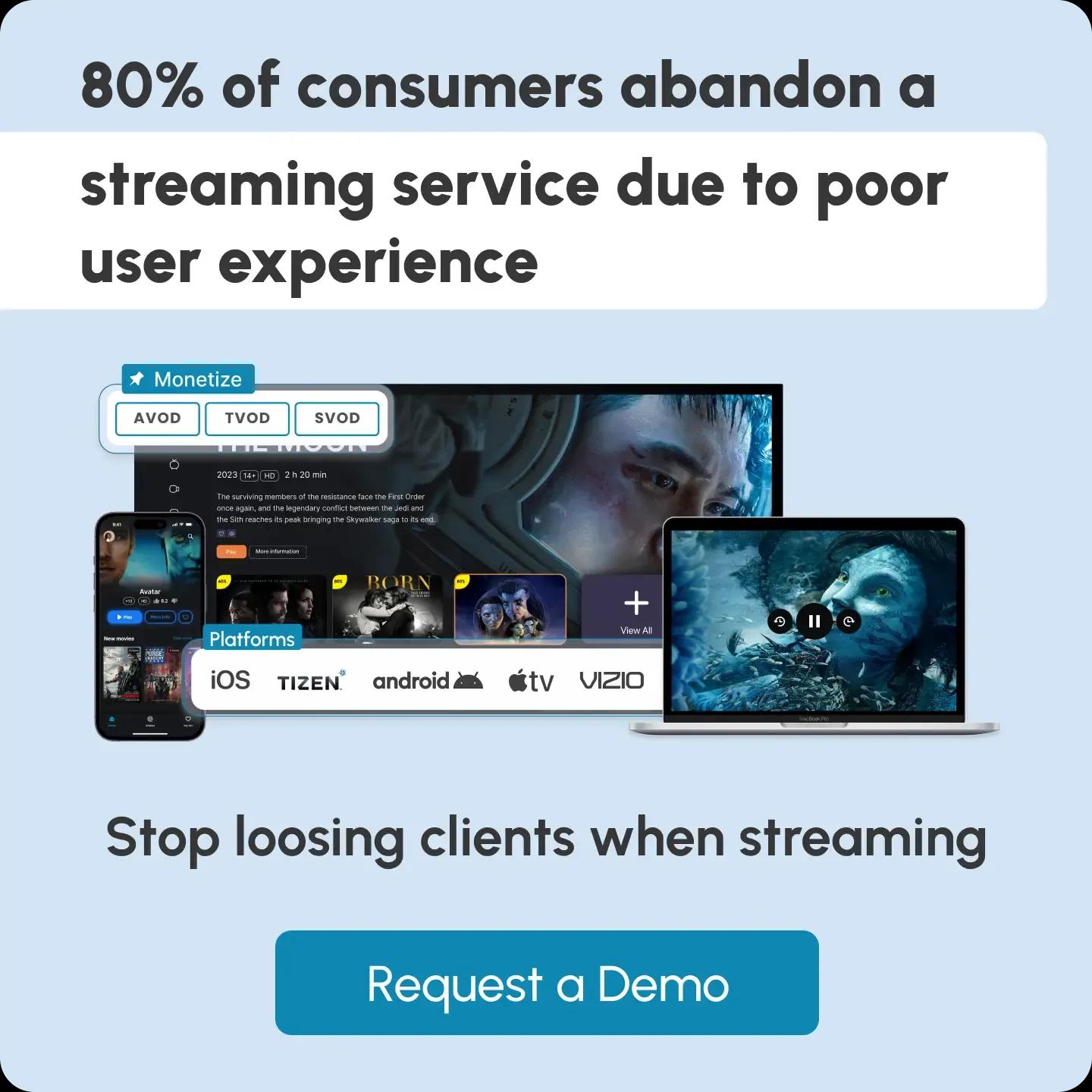
What is SVOD (Subscription Video on Demand)? 2025 Guide
As cable TV fades, Subscription Video on Demand (SVOD) is becoming the go-to way for people to enjoy their favorite shows and movies.
But what is SVOD, how does it work, and why are businesses turning to SVOD platforms to create new revenue streams? This article has all the answers. Let’s dive in!
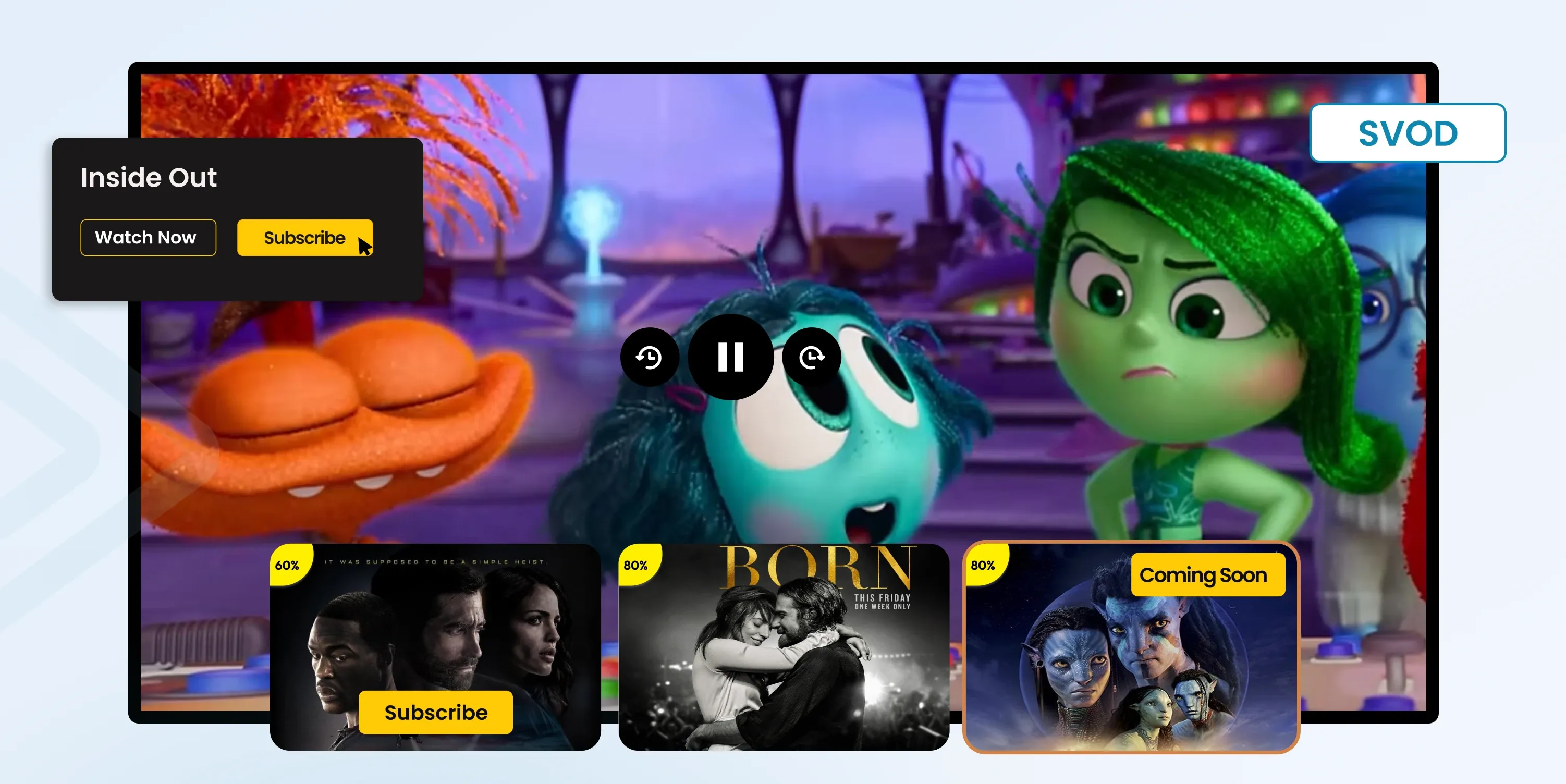
What Does SVOD Stand For?
SVOD stands for Subscription Video on Demand, which is a service that lets users stream content at any time through a regular subscription—offering unfettered access to movies, TV shows, and series.
Unlike traditional cable, SVOD platforms allow users to watch content on-demand without set schedules.
Running an OTT service with SVOD involves delivering content over the internet, bypassing the need for cable or satellite TV.
Industry leader Netflix dominates the sphere, with nearly 270 million global subscribers. This and other major SVOD companies like Amazon Prime and HBO provide vast libraries of content, offering subscribers thousands of choices for a fixed monthly fee.
What sets SVOD services apart is their affordability compared to traditional cable packages, making them an attractive alternative for many households.
By 2027, the SVOD market is estimated to have 1.6 billion users, highlighting the growing popularity of this model.
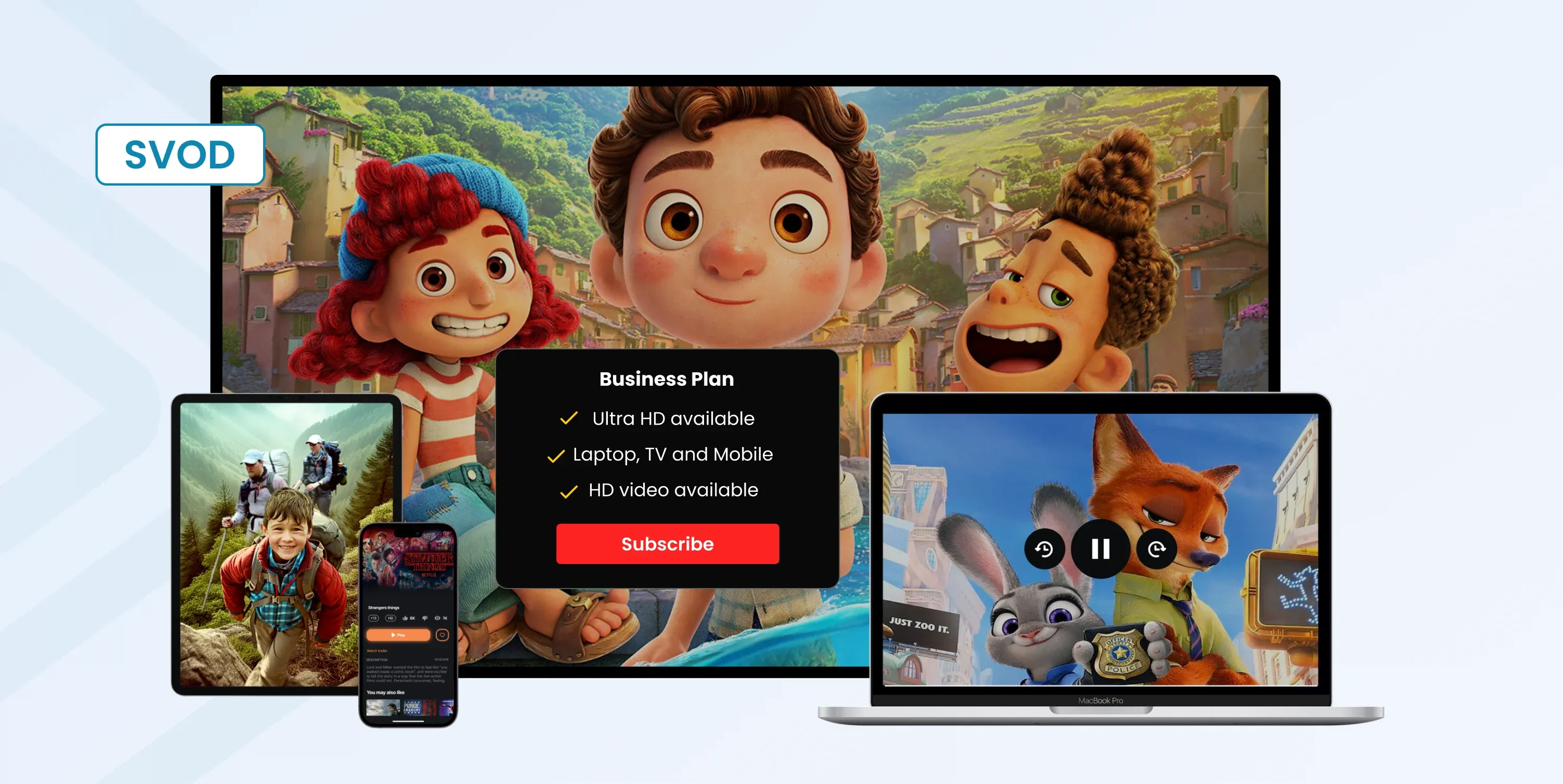 Beyond entertainment, SVOD platforms also offer niche content, such as educational courses, fitness programs, or documentaries, allowing businesses and creators to monetize specialized content. This versatility makes SVOD a powerful tool for generating consistent revenue across various industries.
Beyond entertainment, SVOD platforms also offer niche content, such as educational courses, fitness programs, or documentaries, allowing businesses and creators to monetize specialized content. This versatility makes SVOD a powerful tool for generating consistent revenue across various industries.
SVOD Overview
- Subscription Video on Demand (SVOD) allows users to stream content anytime, anywhere, based on a monthly or yearly subscription.
- Subscribers enjoy ad-free access to movies, series, and TV shows, making SVOD services a leading model for OTT monetization.
- With a fixed subscription fee, SVOD providers benefit from a reliable and recurring revenue stream.
- Major players in the competitive SVOD market include Netflix, Disney+, Amazon Prime Video, and Hulu.
Key Features of SVOD
The appeal of Subscription Video on Demand (SVOD) lies in its flexibility and user-friendly features.
Here are some key reasons why this business model attracts so many consumers:
- Unlimited Viewing: Subscribers can watch as much content as they want within their subscription period, giving them complete control over their viewing experience.
- On-Demand Access: SVOD content is available 24/7. Users can watch their favorite shows or movies whenever it suits them—without being tied to a broadcast schedule.
- Diverse Content Library: SVOD platforms offer a vast selection of genres, including movies, TV shows, documentaries, original series, and niche content. With such an immense variety of content, there’s something for everyone. -**Ad-Free Experience: **One of the biggest draws of SVOD services is the uninterrupted viewing experience. Subscribers can enjoy content without the hassle of ads.
- Multiple Device Compatibility: Whether on a smartphone, tablet, smart TV, or laptop, SVOD platforms allow users to stream content on any internet-connected device, providing maximum flexibility.
- Offline Viewing: Many SVOD providers allow subscribers to download content for offline viewing, which is perfect for traveling or areas with limited internet access.
Top 6 Benefits of SVOD
The SVOD model offers numerous advantages for both service providers and content creators. Here are six top benefits:
1. Consistent Revenue Stream
One of the key advantages of the SVOD model is its ability to generate reliable and recurring income. Subscribers commit to paying a fixed monthly or yearly fee, giving SVOD service providers a predictable cash flow.
2. Greater Control Over Monetization
With SVOD services, content creators have more control over how they monetize and distribute their content. They can experiment with subscription tiers, exclusive content, or bundled offers, allowing for flexible monetization strategies that fit their business model.
3. Building a Loyal Fan Base
Paid subscriptions foster long-term customer relationships. Once users invest in a service, they’re more likely to stay and engage with the content. As such, SVOD platforms can cultivate a devoted audience. This creates opportunities for content creators to nurture loyalty and even upsell premium services.
4. Paywalls for Premium Content
The SVOD monetization model allows content publishers to implement paywalls, granting access only to paying subscribers. Creators can profit from their work while offering exclusive content that attracts users willing to pay for premium, high-quality material.
5. Scalability and Global Reach
Unlike traditional TV, SVOD platforms can easily scale across international markets. With global internet access, businesses can reach a wider audience. They can expand their revenue potential without the geographical limitations faced by traditional media.
6. Data-Driven Insights
SVOD services typically provide valuable analytics on viewer behavior, preferences, and engagement. With these insights, content providers can refine their offerings, recommend personalized content, and create targeted marketing strategies. All of these aspects lead to increased customer retention.
Monetization with SVOD
As a key player in the OTT market, SVOD continues to expand due to the increasing number of streaming platforms and the growing demand for on-demand content. To thrive in this competitive space, platforms must focus on building large, diverse content libraries that attract and retain subscribers.
Here’s how providers can effectively monetize with SVOD:
Create a Vast Content Library
Offering a broad selection of high-quality content across various genres helps attract a wide audience. Diverse content keeps users engaged and reduces the likelihood of subscriber churn, ensuring long-term retention.
Optimize Subscription Plans
Develop tiered pricing models to appeal to different customer segments. By offering premium tiers with added perks, such as exclusive content or early access, you can boost average revenue per user (ARPU) and encourage upgrades.
Enhance User Experience
A smooth, user-friendly interface is essential to keeping viewers satisfied. Personalized recommendations, easy navigation, and multi-device compatibility contribute to a positive user experience, encouraging subscribers to stay longer.
Leverage Partnerships and Data
Form strategic alliances with other content creators, brands, or distribution channels to increase your reach. Additionally, utilize viewer data to personalize content recommendations and create targeted marketing campaigns to drive engagement and retention.
Major SVOD Platforms
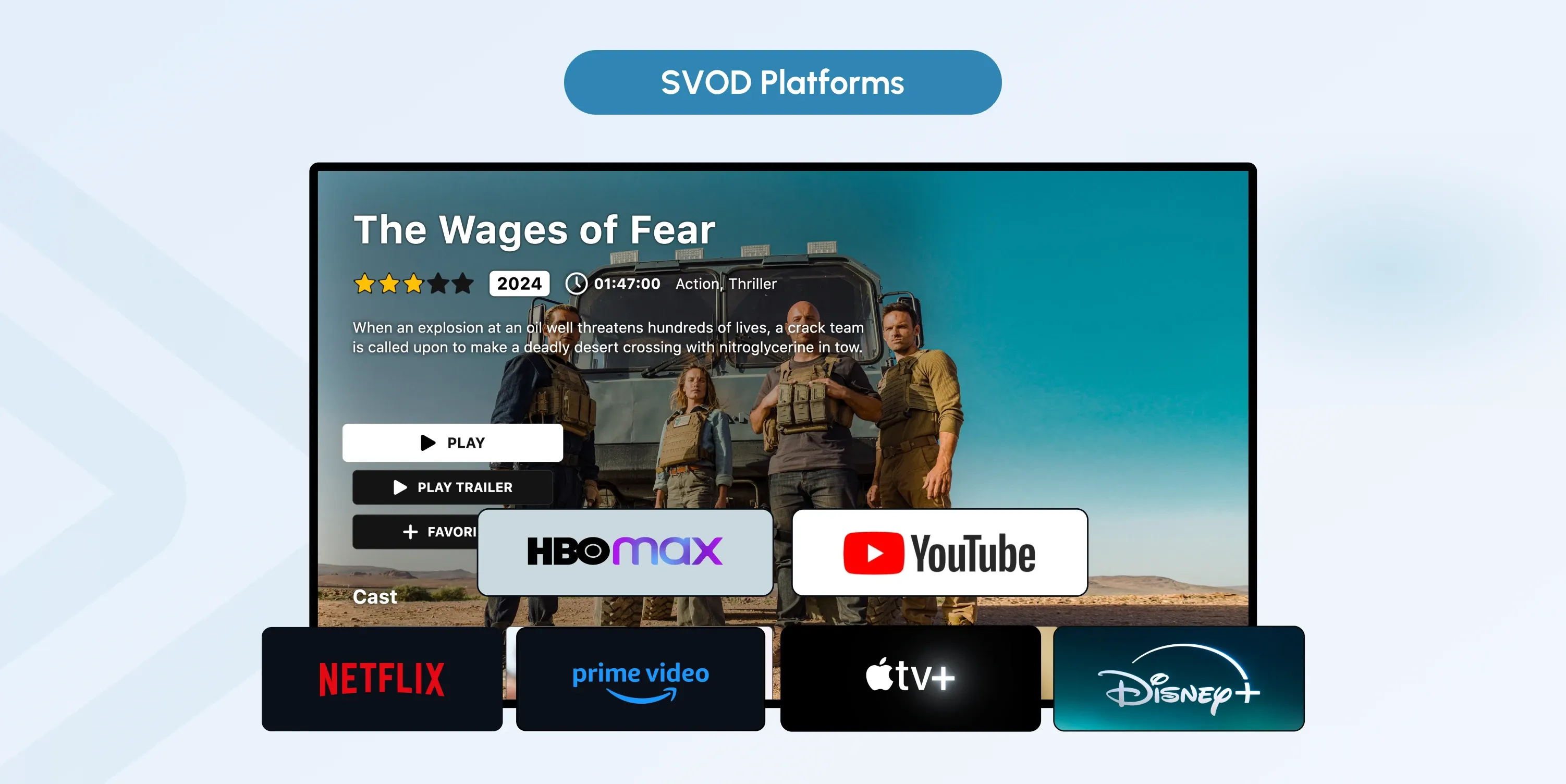 Several leading platforms dominate the SVOD market, offering a mix of original and licensed content. Here are the most well-known SVOD services:
Several leading platforms dominate the SVOD market, offering a mix of original and licensed content. Here are the most well-known SVOD services:
- Netflix With over 260 million subscribers worldwide, Netflix is the largest and most popular SVOD platform. It offers a vast library of original content, such as hit shows like Stranger Things, alongside licensed movies and TV series. Netflix’s personalized recommendations, based on the user's viewing history, help enhance the overall experience.
- Amazon Prime Video
Included with an Amazon Prime membership, Amazon Prime Video is a top contender in the SVOD services space. In addition to a wide range of licensed TV shows and movies, it features exclusive originals like The Boys and The Marvelous Mrs. Maisel. Prime members also enjoy perks like free two-day shipping and access to Amazon Music. - Disney+ A relatively newer player in the SVOD market, Disney+ offers exclusive content from Disney, Marvel, Star Wars, and National Geographic. Its growing library includes popular original series like The Mandalorian as well as beloved classics from Disney’s vault, making it a must-have for fans of family-friendly entertainment.
- Hulu
Hulu combines original programming with a large selection of licensed content, offering shows like The Handmaid’s Tale. Subscribers can also add premium channels like HBO and Showtime for an extra fee. There's even an option for live TV, making Hulu a versatile SVOD platform. - HBO Max HBO Max is a subscription-based video platform with an extensive catalog of TV shows, films, and exclusive programming, including iconic HBO series like Game of Thrones and Succession. Subscribers can also access live TV and premium channels like Cinemax for an additional charge.
- Apple TV+
Apple TV+ focuses on original content like Ted Lasso and The Morning Show. The SVOD service also offers licensed shows and allows users to download content for offline viewing. Personalized recommendations help users discover new content based on their preferences. - YouTube Premium YouTube Premium offers ad-free viewing of all YouTube videos, access to original content, and the ability to download videos for offline use. It's a unique subscription-based video platform, blending traditional streaming features with the vast video library of YouTube.
AVOD vs. SVOD vs. TVOD: Key Differences
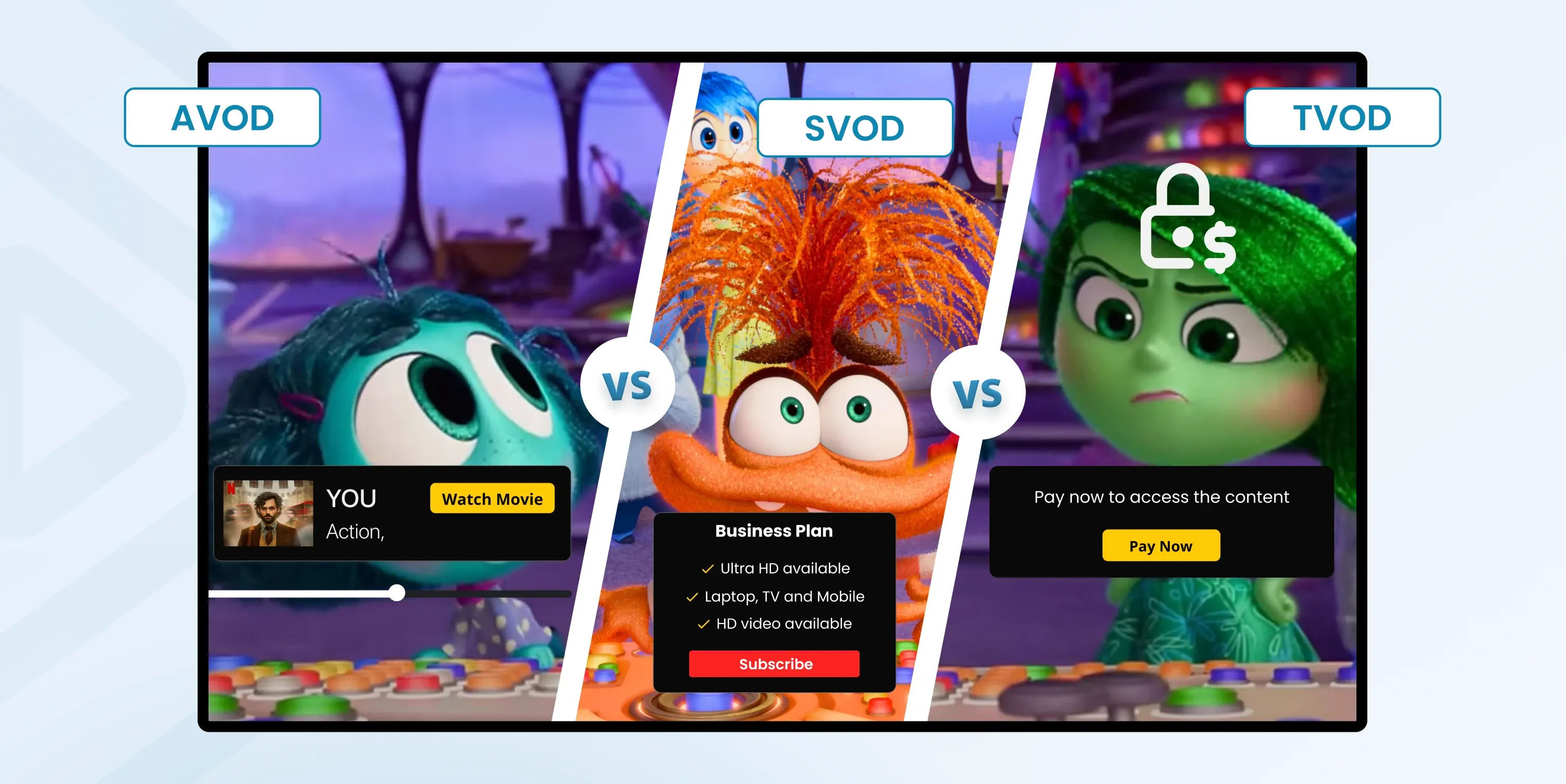 To better understand the meaning of SVOD, it helps to look at the different types of video-on-demand services. There are three main models: SVOD, AVOD, and TVOD. Each offers unique ways to monetize content, with different approaches to pricing and viewer experience.
To better understand the meaning of SVOD, it helps to look at the different types of video-on-demand services. There are three main models: SVOD, AVOD, and TVOD. Each offers unique ways to monetize content, with different approaches to pricing and viewer experience.
What are the Main Characteristics of AVOD vs. SVOD vs. TVOD?
Ad-Supported Video on Demand (AVOD) provides free access to content, but users must watch ads periodically. Platforms like Pluto TV, Tubi, Freevee, and Peacock TV use this model, showing short ads before and during content.
Viewers don’t pay for the content—making AVOD a great option for those looking to watch without a subscription.
Subscription Video on Demand (SVOD) allows users to stream content at any time in exchange for a recurring subscription fee. SVOD platforms are ad-free, giving subscribers uninterrupted access to movies, series, and shows. Popular SVOD services like Netflix and Disney+ charge a monthly or yearly fee, offering unlimited viewing within the subscription period.
Transactional Video on Demand (TVOD) offers pay-per-view content, where users purchase or rent individual shows or movies. This model is common for new releases and special events. It allows viewers to access specific content without committing to a subscription.
Platforms like Amazon Prime Video allow users to buy or rent movies or episodes as needed, making it a flexible option for those who prefer to pay only for what they watch.
Choosing the Right Monetization Method
To make an efficient choice for OTT monetization, let’s answer the questions below using comparison tables.
What Content Works Best for Each VOD Model?
| Monetization Method | Best for |
|---|---|
| SVOD | Exclusive series, documentaries, and original programming |
| TVOD | Special releases, live events, or one-time content like blockbuster movies or exclusive concerts |
| AVOD | General entertainment content, free movies |
Which VOD Model Is Best for Your Business?
| Monetization Method | Best for |
|---|---|
| SVOD | Consistent, recurring revenue |
| TVOD | Monetizing exclusive or one-time content like new releases or live events |
| AVOD | Offering free access with ad-based income and reaching a large user base |
Challenges Facing SVOD Services Providers
The SVOD model has certain drawbacks, even if its use and benefits are evident. Providers must focus on expanding their audience, reducing churn, and retaining subscribers in an increasingly competitive market.
Reaching a Broader Audience
Since SVOD services require a paid subscription, they may attract fewer viewers compared to free, ad-supported platforms. Convincing users to pay for content when there are free alternatives is a challenge, especially in regions where affordability is a concern.
Attracting and Retaining Subscribers
To stand out in a crowded marketplace, SVOD platforms need a vast and diverse content library. Smaller providers or independent content creators may struggle to compete with major players like Netflix or Amazon. For instance, a limited selection of shows and movies may not be enough to attract and retain subscribers in today’s fractured media landscape.
Reducing Subscriber Churn
One of the biggest hurdles for SVOD companies is keeping users engaged and preventing them from canceling their subscriptions. High churn rates can severely impact profitability. While the cost of acquiring new subscribers is high, the expense of re-engaging former users can be even higher.
Future Trends in SVOD
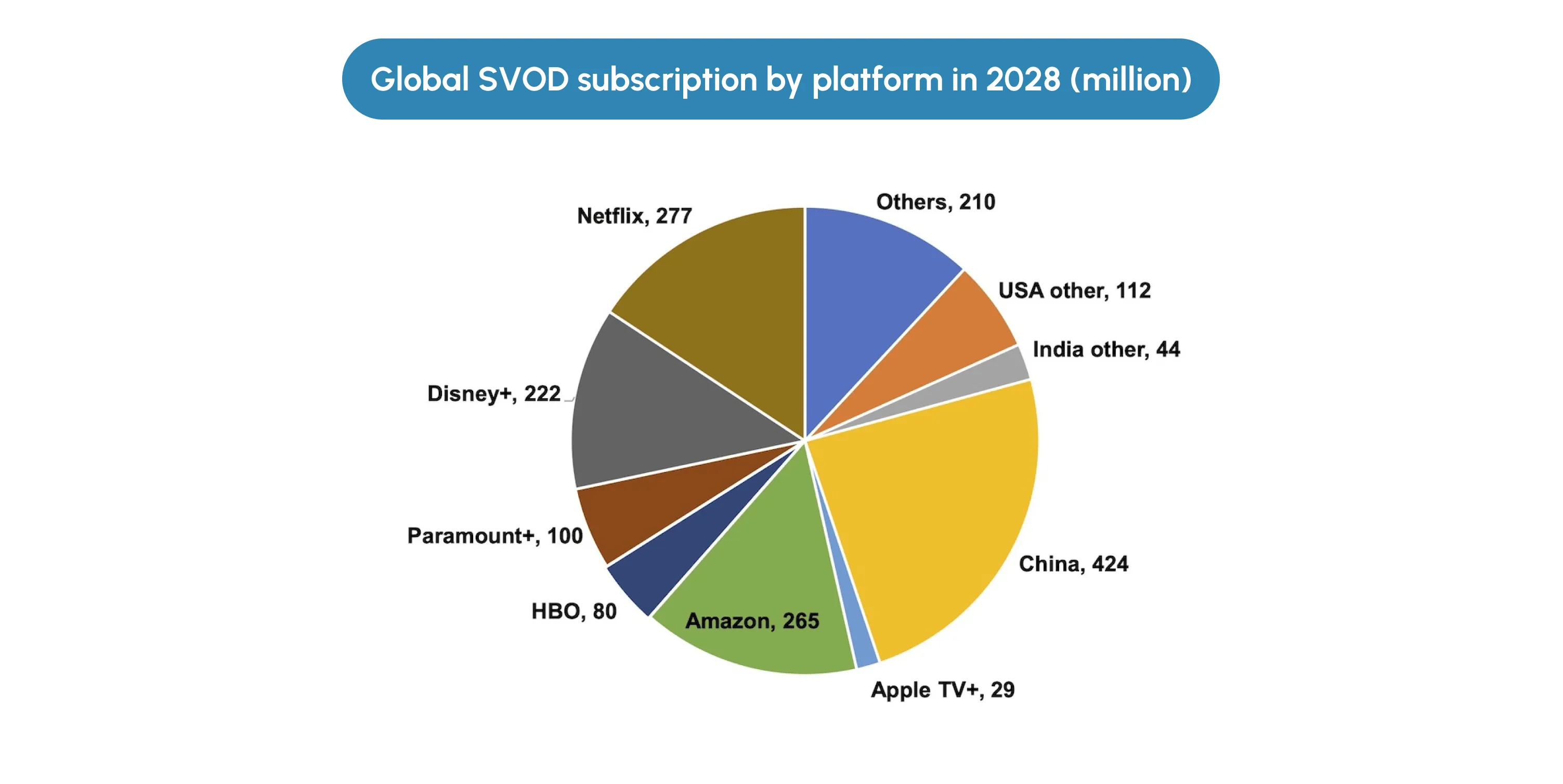 The entertainment industry has shifted dramatically in the past decade, with more people choosing to subscribe to streaming services. While that trend continues, Omdia’s research shows some key changes in how SVOD is consumed.
The entertainment industry has shifted dramatically in the past decade, with more people choosing to subscribe to streaming services. While that trend continues, Omdia’s research shows some key changes in how SVOD is consumed.
By 2024, the SVOD services market is expected to reach over $108.5 billion, with an annual growth rate of 8.27%, pushing the market to $137.7 billion by 2027.
One noticeable shift is in how people manage their subscriptions. Previously, viewers would subscribe to multiple platforms for variety. Now, more are being selective and sticking to just a few key providers that fit their preferences and budgets.
Here are some other trends shaping the future of SVOD:
1. Content Bundling
Expect to see more SVOD companies offer bundled services, where multiple subscriptions are grouped into one package at a discount. It’s a way to offer more content for less, retain subscribers, and stand out from the competition.
2. Localized and Niche Content
More platforms are creating content tailored to specific regions or niche interests. This approach helps platforms reach new audiences and engage viewers. By offering unique content, they can cater directly to specific tastes or cultures.
3. Hybrid Models
Many SVOD platforms are adopting hybrid models that combine ad-supported (AVOD) and ad-free tiers to boost profitability. However, Free Ad-Supported Streaming (FAST) services like Samsung TV Plus, Pluto TV, and Freevee are quickly gaining ground, now present in over 1 in 3 households.
4. Personalization with AI
AI algorithms now analyze users' habits, preferences, and even subtle patterns to suggest content that feels hand-picked.
This deeper level of personalization is what will set platforms apart, as viewers increasingly expect their streaming service to “know” them.
Leveraging inoRain for SVOD Solutions
inoRain brings cutting-edge OTT technology to your SVOD platform, delivering seamless, high-quality streaming. With inoRains’ multi-device support, your content will be accessible on smartphones, tablets, smart TVs, and TV boxes—so your subscribers can stream their favorite shows anywhere, anytime.
When it comes to security, inoRain leads the way with multi-DRM protection to safeguard your content from piracy and unauthorized access, ensuring your subscribers securely enjoy your service.
Looking for powerful customization? With inoRain, you can create your own branded OTT platform with a complete OTT feature set, including:
- Monetization tools for SVOD and other models
- Centralized user management
- In-depth statistics and reports
- Location metrics
- Streaming monitoring
- Content management
- Billing management
Ready to scale or start your SVOD platform? Partner with inoRain today.
Conclusion
If you're looking to provide consistent, valuable content while generating steady revenue, SVOD could be your ideal path. Experimenting with various monetization models—SVOD, TVOD, or even hybrids—can help you discover what works best for your business. So, take your time to adjust and grow.
For now, are you ready to take the next step? Start building your SVOD platform with inoRain and explore the possibilities of growing your audience while maximizing your revenue.
Frequently Asked Questions
Co-founder / CTO
Hi, I'm Armen, the CTO and Co-Founder of inoRain OTT, as well as the Co-Founder of HotelSmarters. With 15+ years of background in digital streaming technology, I specialize in OTT strategies and interactive TV solutions, helping businesses maximize their revenue potential. At HotelSmarters, I focus on leveraging tech to transform hotel operations, while at inoRain, I drive innovation in end-to-end OTT solutions. Let’s connect and explore new opportunities!

OTT Advertising: Types, Best Practices, and Strategies
Over-the-top (OTT) advertising has transformed how brands connect with consumers.

VPlayed Alternatives: inoRain vs. VPlayed
Explore inoRain as a VPlayed alternative, comparing features, pricing, and OTT solutions to find the best platform for your streaming needs.

Custom OTT Platform Development: How to Start an OTT Business
This guide will walk you through everything you need to know about the OTT platform development.
